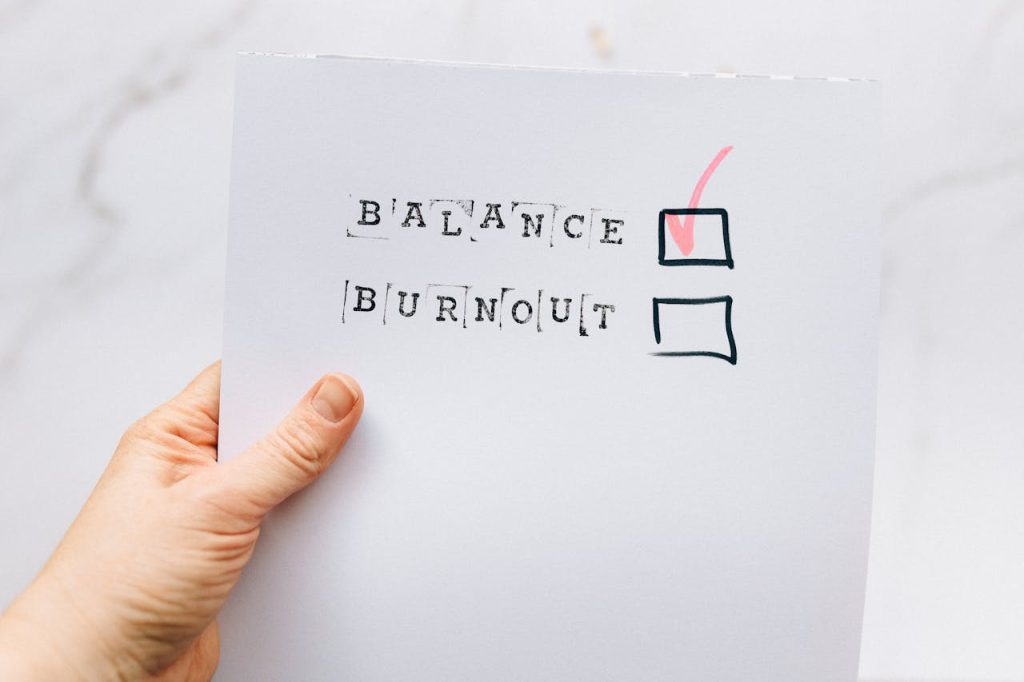Burnout Symptoms

In today’s fast-paced world, burnout has become an all-too-common issue, affecting not only our professional lives but also our personal and family relationships. Recognizing the early signs of burnout and implementing effective strategies to combat it can help you reclaim your vitality and maintain a healthy balance. Let’s dive into eight powerful strategies to recognize burnout symptoms and rejuvenate your life.
Recognize the Early Signs of Burnout
The first step in combating burnout is recognizing its early signs. Burnout often starts subtly, with symptoms that can easily be mistaken for everyday stress. However, if left unchecked, these symptoms can escalate into more severe issues. Emotional exhaustion is a key indicator, where you feel drained and unable to cope with the emotional demands of your life. This can manifest as chronic fatigue, irritability, and a sense of being overwhelmed.
Another sign is detachment and disconnection. You may find yourself withdrawing from social interactions, feeling isolated, and losing interest in activities you once enjoyed. Increased conflict, both at work and at home, is also a red flag. Burnout can make you more irritable and prone to arguments, straining your relationships.
Physical symptoms such as headaches, muscle tension, and sleep disorders are common in burnout. These physical manifestations can further exacerbate emotional and mental stress, creating a vicious cycle. Recognizing these early signs is crucial for timely intervention and preventing burnout from taking a more severe toll on your life.
Promote a Healthy Work-Life Balance

A healthy work-life balance is essential in preventing burnout. In our hyper-connected world, the lines between work and personal life often blur, leading to increased stress and burnout. To promote a healthy balance, start by setting clear boundaries. Establish specific work hours and stick to them, avoiding the temptation to check emails or work-related messages during your personal time.
Flexible working hours and remote work options can also help. These arrangements allow you to tailor your schedule around personal commitments, reducing stress and improving overall well-being. Encourage your employer to implement policies that support work-life balance, such as limiting after-hours communication and promoting the use of paid time off.
Taking regular breaks throughout the day is another effective strategy. Short breaks can help you recharge and maintain focus, preventing the buildup of stress. Make time for activities that bring you joy and relaxation, whether it’s spending time with family, pursuing hobbies, or simply unwinding with a good book.
Foster a Supportive Work Environment
A supportive work environment is crucial in mitigating burnout. When employees feel valued and respected, they are more likely to be engaged and motivated. Managers play a key role in creating this environment. Prioritize tasks effectively and set clear expectations to reduce stress. Regular recognition and meaningful feedback can reinforce a sense of value among employees, mitigating feelings of isolation and burnout.
Encourage open communication and provide opportunities for employees to voice their concerns. This can be done through regular one-on-one meetings, team check-ins, and anonymous feedback channels. Creating a culture of support and understanding can help employees feel more connected and less overwhelmed.
Encourage Professional Development
Career stagnation can lead to disengagement and burnout. Providing opportunities for professional development can help employees develop new skills and advance in their careers, enhancing their engagement and productivity. This can include mentoring programs, leadership training, and support for further education.
Encouraging employees to set career goals and providing the resources to achieve them can also boost motivation and job satisfaction. When employees see a clear path for growth and development, they are more likely to stay engaged and committed to their work.
Implement Meaningful Recognition Programs
Recognition and rewards are strongly correlated with reduced burnout. A lack of recognition makes employees more likely to report burnout. Implementing a company-wide recognition strategy that acknowledges specific achievements can make employees feel valued and appreciated, reducing stress and enhancing job satisfaction.
Recognition doesn’t always have to be monetary. Simple gestures such as a thank-you note, public acknowledgment, or a small token of appreciation can go a long way in boosting morale and motivation. Regularly celebrating milestones and successes can create a positive work environment and foster a sense of community.
Reduce Unnecessary Meetings
Excessive meetings can disrupt focus and add to an already stressful workload. Cutting back on unnecessary meetings and improving meeting agendas can help employees manage their time more effectively, reducing frustration and burnout. Before scheduling a meeting, consider whether the issue can be resolved through email or a quick chat.
When meetings are necessary, ensure they are well-organized and have a clear agenda. Start and end on time, and encourage participants to stay focused on the topic at hand. This can help make meetings more productive and less time-consuming, allowing employees to focus on their core tasks.
Set Clear Boundaries
The blurring of boundaries between work and personal life, especially in remote work settings, can contribute to burnout. Setting firm boundaries that stop after-hours contact unless it’s an emergency can help employees manage their stress levels and maintain a healthier work-life balance.
Communicate your boundaries clearly to your employer and colleagues. Let them know your working hours and when you are available for work-related matters. Stick to these boundaries and resist the urge to check work emails or messages during your personal time. This can help you disconnect and recharge, reducing the risk of burnout.
Monitor and Adjust Strategies Regularly
Addressing burnout is an ongoing process that requires constant vigilance and adaptability. Regularly soliciting employee feedback through surveys, focus groups, or one-on-one meetings can help HR and leadership tailor interventions to meet the specific needs of their workforce. Being flexible and responsive to feedback ensures that strategies remain effective in supporting employee well-being.
Regularly review and adjust your strategies based on feedback and changing circumstances. What works today may not be effective tomorrow, so it’s important to stay proactive and open to new approaches. This can help create a resilient and adaptable work environment that supports employee well-being and prevents burnout.
Conclusion
Burnout is a pervasive issue that affects not only our professional lives but also our personal and family relationships. Recognizing the early signs of burnout and implementing effective strategies to combat it can help you reclaim your vitality and maintain a healthy balance. By promoting a healthy work-life balance, fostering a supportive work environment, encouraging professional development, implementing meaningful recognition programs, reducing unnecessary meetings, setting clear boundaries, and regularly monitoring and adjusting strategies, you can prevent burnout and create a more positive and productive life.
Remember, addressing burnout is an ongoing process that requires constant vigilance and adaptability. Stay proactive, listen to feedback, and be open to new approaches. By doing so, you can create a resilient and adaptable environment that supports well-being and prevents burnout. Reclaim your vitality and enjoy a healthier, more balanced life.

